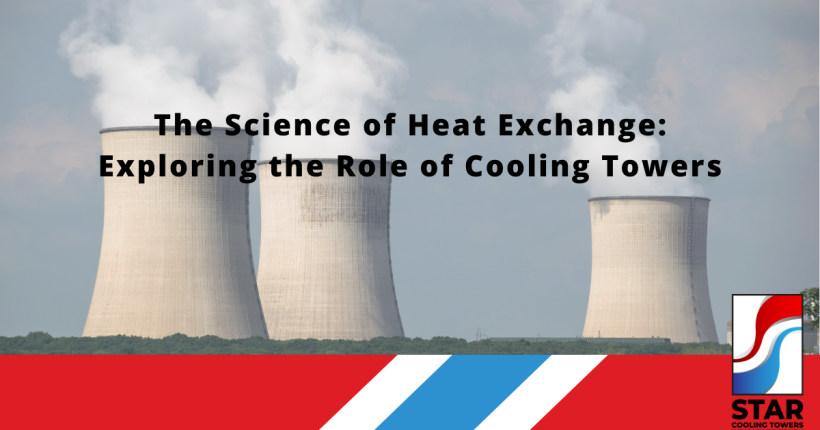The science of heat exchange is a critical feature of modern life—a silent force operating behind our process cooling systems. Cooling towers play an integral role in this delicate dance of energy transfer, ensuring that excess heat is dissipated efficiently and safely.
In this deep-dive blog post, we’ll explore the world of cooling towers, dissecting the intricacies of heat exchange and unveiling the vital functions they perform. Whether you’re an engineer, an industrial plant manager, or an HVAC professional, this compendium on the subject is designed to foster a deeper understanding of industrial cooling towers and enhance your ability to optimize their function.
Understanding Heat Exchange
Heat exchange is the process by which thermal energy is transferred between materials of different temperatures. It is everywhere, from your teapot to your car’s radiator, an essential mechanism that allows systems to reach and maintain a desired temperature. In industrial settings, where monumental processing tasks generate substantial heat, specialized equipment like cooling towers is crucial for managing this energy transfer.
The Principles of Heat Exchange
The first law of thermodynamics—energy cannot be created or destroyed, only transformed—sets the stage for heat transfer. When two substances of different temperatures come into contact, thermal energy moves from the warmer to the cooler material until an equilibrium is reached. This fundamental principle underpins not just the concept of heat exchange, but much of what we understand about overall heat transfer coefficient.
Cooling Towers in Action
Cooling water towers come into play where substantial amounts of heat need dissipation, as seen in power plants, petrochemical plants, food processing plants, etc. and large industrial facilities. These towering beacons of industry leverage the principles of heat exchange to transfer heat into the atmosphere, effectively cooling the process fluid (usually water) and completing the cycle of energy transformation.
Types of Cooling Towers
Not all cooling towers are created equal. Here, we’ll dissect the two primary designs and elaborate on the open-loop and closed-loop systems they serve.
Crossflow vs. Counter flow
Crossflow and Counter flow cooling towers represent the two main heat exchange configuration designs. In crossflow towers, air moves horizontally across the flow of falling water, offering better access to air and reducing the amount of water that gets recirculated. Counter flow towers, on the other hand, have air moving upwards, opposing the downward flow of the water. This design typically offers better thermal efficiency and a smaller footprint than crossflow towers.
The Double Pipe Heat Exchanger
Another fascinating aspect of the heat exchange world is the double pipe heat exchangers, often considered the simplest form of heat exchanger. Comprising two concentric pipes, one carrying the process fluid and the other carrying the cooling or heating fluid in counter flow arrangement, this design is both versatile and effective. Its simplicity lends itself to easy maintenance and adaptability for a variety of industrial applications, from chemical processes to HVAC systems.
Efficiency and Performance Factors
The efficiency of a cooling tower is a crucial metric, impacting everything from operational cost to environmental impact. Understanding the factors that influence this efficiency is imperative for engineering and operational teams.
Influencing Efficiency
Several factors can impact cooling tower efficiency, including ambient wet-bulb temperature, the purity of the process water, and the design configuration. Design elements such as the cross-sectional area for airflow and the amount of surface area for heat transfer are primary contributors to overall effectiveness.
Maintenance and Treatment
Regular maintenance and proper water treatment are cornerstones of reliable cooling tower operation. Scaling, corrosion, and biological growth can significantly reduce heat transfer efficiency and pose health risks. Implementing decent water treatment systems, antifoulant coatings, and regular inspection schedules can mitigate these risks and promote long-term performance.
Applications in Industry
Cooling towers play a crucial role in a variety of industrial processes, from HVAC systems to oil refineries. Understanding their use in these applications can shed light on their versatility and importance.
Industrial Plant Cooling
In industrial settings, cooling towers serve processes like power generation, manufacturing, and wastewater treatment. They contribute to maintaining equipment temperatures and ensuring that byproducts are managed within environmental regulations.
Plate Heat Exchanger
Plate heat exchangers represent another innovative configuration crucial for achieving efficient heat transfer in many industrial applications. Characterized by their compact, stacked plate design, these exchangers facilitate heat transfer between two fluids without them mixing. The process fluids flow through alternate spaces created by the plates, and the large surface area of the plates enables highly efficient thermal transfer. Due to their design, plate heat exchangers are especially beneficial in applications requiring significant heat recovery or where space is at a premium. Their efficiency not only reduces energy costs but also contributes to the sustainability of operations by minimizing environmental impact. This makes plate heat exchangers a favored choice in industries ranging from food and beverage processing to chemical manufacturing and power generation. air cooled heat exchanger
Conclusion
Cooling towers are indelibly linked to the complex workings of industrial cooling and environmental management. By understanding the mechanics behind heat exchange and the crucial role that cooling towers play, engineers and industrial professionals can better serve their respective fields.
Optimizing the efficiency of cooling towers is not just a practical measure for reducing costs and improving performance but a reflection of our approach to sustainable operations and energy management. By staying informed of the latest advancements and best practices, professionals in this space can ensure that cooling towers continue to stand as pillars of reliable, efficient heat exchange in the years to come.
In your own industrial pursuits, take the knowledge gleaned from this exploration and apply it to the scrutiny of your cooling tower operation. Identify areas for enhancement, invest in the right maintenance strategies, and keep your finger on the pulse of emerging technologies. At every turn, your efforts will not only improve the bottom line but contribute to the larger crusade for responsible resource management.


